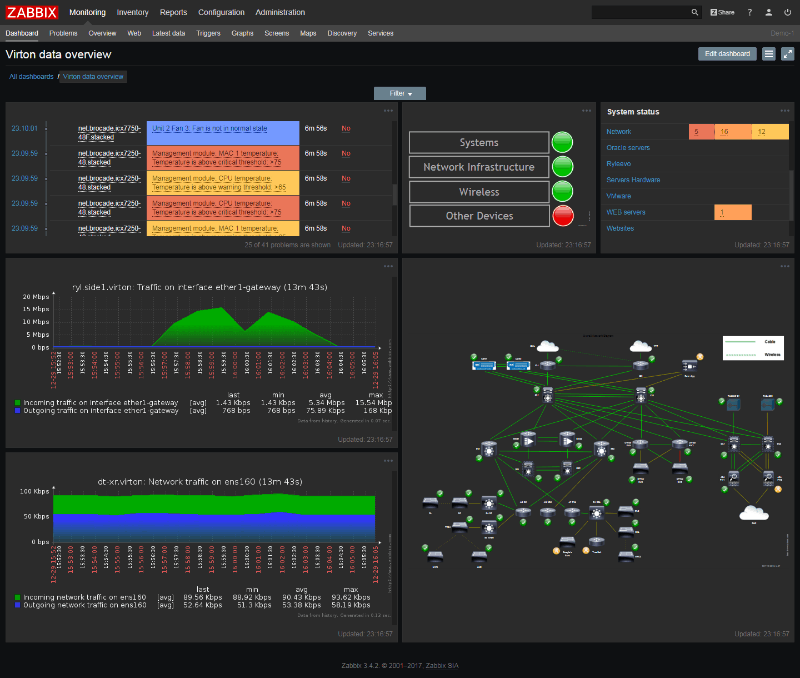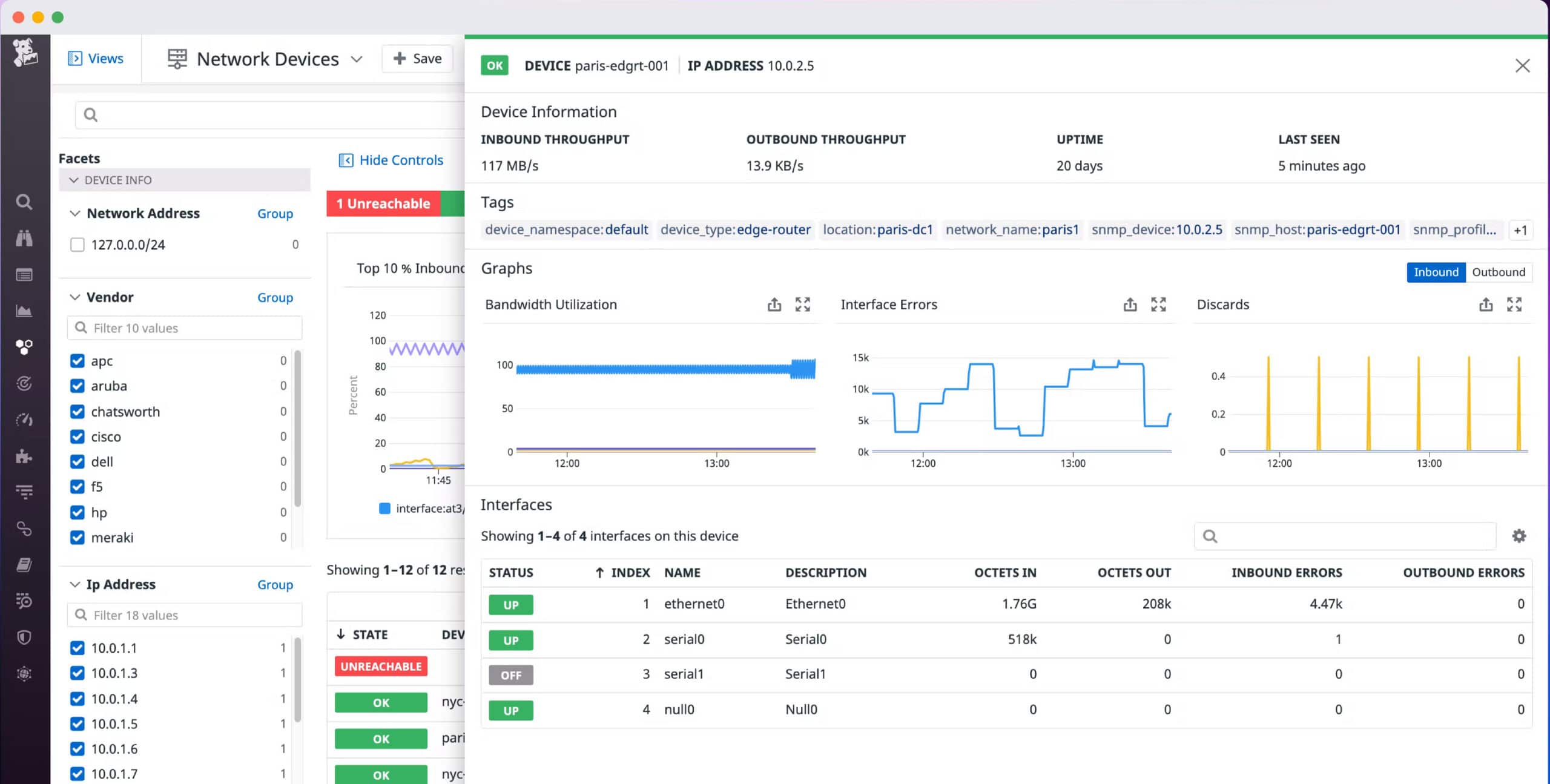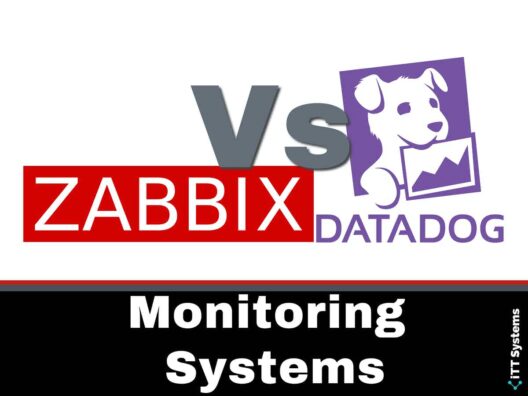Network monitoring tools must be a critical part of your IT infrastructure as they proactively identify vulnerabilities and help you to fix them before it impacts users. There are many network monitoring tools in the market today and each comes with its unique features. Identifying the appropriate tool is not easy and this is where we come in.
We conduct in-depth research to give you accurate information about each tool to help you make informed decisions about your software purchases. Further, we compare the popular tools against each other, so you know which one is better for your organization.
In this comparison series, today, we'll be looking at the similarities and differences between Zabbix and Datadog.
About Zabbix

Zabbix is an enterprise-class infrastructure monitoring platform that can be deployed for both agentless and agent-based monitoring of different IT assets. It is often used for monitoring cloud services, workstations, end-point devices, servers, storage devices, and more, and works well across many operating systems such as Linux, Solaris, Windows, Unix, Mac OS, and more.
Typically, Zabbix monitors each IT asset through an agent that reports back critical information to the main server. In turn, this information is collated to provide insights into important metrics such as CPU load, bandwidth utilization, storage space consumption, and more. Using this information, you can make informed decisions to improve the efficiency and security of your IT infrastructure.
Also, Zabbix uses this information to send alerts if the metrics are abnormal. As a part of these notifications, it also sends the context around the issue to help you zero in on the cause at the earliest. This way, you can fix an issue before it impacts your operations. Lastly, Zabbix generates advanced reports that can be used for internal and external auditing. It helps to also comply with industry-leading standards such as HIPAA, GDPR, and more.
Pros:
- Open-source transparent tool
- Uses both SNMP and ICMP for a broader monitoring range
- Can detect new devices and configuration changes immediately
- Offers useful templates for quick insights
- Robust notification system supports SMS, email, custom script, and webhook
Cons:
- The interface isn’t as intuitive as solutions such as DataDog or Site24x7
- Would like to see better-alerting features, specifically related to reducing false positives
About Datadog

Datadog is a monitoring service that stays on top of the health and performance of your different IT components such as servers, workstations, apps, cloud and SaaS services, automation and instrumentation tools, databases, and more. This cloud service monitors the above-mentioned components and notifies you in case of problems. It monitors and reports both for individual components as well as for clusters.
Further, it monitors a wide range of metrics and events across the entire tech stack. As a result, it can provide a comprehensive idea of your overall stack and along with it, can provide the necessary context and information needed for fixing any bugs or vulnerabilities in your network. You can also track requests, bug fixes, and other activities within the organization to understand the progress of each.
All this information helps you to proactively ensure the well-being of your network and optimize your resource usage. Plus, it manages your SLAs and generates custom reports for your auditing and compliance needs.
At first glance, both Datadog and Zabbix seem similar. Both tools monitor your IT components and their performance and help you with troubleshooting when needed. But a closer look shows that there are some differences between these two tools, which means, one tool is better suited for certain environments and businesses than others. In this context, let's compare the two tools to better understand their differences.
Pros:
- Offers numerous real user monitors via templates and widgets
- Can monitor both internally and externally giving network admins a holistic view of network performance and accessibility
- Changes made to the network are reflected in near real-time
- Allows businesses to scale their monitoring efforts reliably through flexible pricing options
Cons:
- Would like to see a longer trial period for testing
Differences Between Zabbix and Datadog
In this section, let's compare the two tools across many parameters to understand the significant differences between the two platforms.
Infrastructure Requirements
As a first step, what do you need to install the two monitoring platforms? Zabbix is an on-prem service that runs on Linux. It requires a minimum of 128MB of physical memory and 256MB of free disk space to install.
Datadog, on the other hand, is a cloud-based SaaS and doesn't require any resources. However, if you choose to go with agent-based monitoring, you'll have to install local agents for each device or service that you want to monitor.
Technical Skills
Zabbix requires a certain level of technical skill to set up and use. You'll have to preconfigure virtual applications for VMware, Azure, etc. Though there are many out-of-the-box templates, still you need some technical expertise for installation and configuration.
Datadog doesn't require any such complex installation or configuration, and hence, no advanced technical skills are required. Probably the only complex integration is with VMware's vSphere. The good news though is that Datadog's documentation is extensive and provides a step-by-step guide through installation.
Dashboards
Zabbix comes with a modern and clean-looking dashboard, where you can easily find the information you want. A highlight of this tool is that it is highly customizable, so you can include any kind of information you need. Though this customization requires a bit of coding, still the flexibility it offers is worth the effort. It also scores high on usability.
Datadog's dashboards are also appealing and advanced. It also supports customization with its drag-and-drop widgets and integrations, but the effort required for such customization is high. A unique aspect of Datadog is that it offers two types of dashboards – screen boards and time boards.
Screenboards are grid-based layouts where you can have images, charts, graphs, and just about any kind of object you want. A time-based dashboard, on the other hand, displays different parameters at a specific time. This information can come in handy to understand trends and to help with troubleshooting.
Notifications
There are some differences in the way notifications are handled across both platforms. In Zabbix, you can establish a clear flow of notifications and escalations. For example, let's say, the CPU load is high and Zabbix sends a notification to the concerned employee. When it sees no actions or changes, Zabbix will automatically escalate this issue to that employee's reporting manager or another individual, based on how you've set up the workflow.
Datadog doesn't have escalations or workflows in its notifications, but the information that it sends out is accurate and provides all the context needed to fix the problem. Datadog's notification service is called WatchDog and its accuracy reduces the chances of false positives and alert fatigue.
Pricing
This is one area where Zabbix has a clear edge over other platforms. Its platform is 100% FREE and there are no hidden costs either. However, you'll have to pay for technical support. Most organizations go for this support package as it helps with configuration and installation. Still, the savings are huge and can be highly beneficial for small businesses.
Datadog, on the other hand, comes with a reasonably-priced option that's based on the number of resources you want to monitor each month. It also offers a ton of services and you can choose just the ones you need to make the most of Datadog within your budget.
APIs
Both platforms come with APIs for extensibility, but with some differences.
Zabbix offers web APIs to integrate it with third-party and even custom applications. It also comes with plugins to provide the flexibility to use Zabbix across different tools and environments. Datadog doesn't offer plugins but comes with HTTP REST APIs to extend its functionality through programming code. In this sense, both platforms are extensible, but the method to extend their capabilities vary.
Thus, these are some of the key differences between Zabbix and Datadog.
Zabbix vs Datadog – Differences at a Glance
Here's a glance at the differences between these two monitoring platforms.
| Features | Zabbix | Datadog |
|---|---|---|
| Installation | Linux-based on-prem installation | Cloud service |
| System requirements | Minimum requirement is 256MB of disk space and 128MB of physical memory | None, as it is a SaaS. But you have to install agents for agent-based monitoring |
| Technical skills | Required | Optional |
| Customizable dashboards | Highly customizable, but coding is required | Reasonably customizable with drag-and-drop widgets |
| Notifications | Workflow-based for built-in escalations | Accurate and provides context |
| Pricing | 100% Free. Pay only for technical support | Paid, but with a lot of flexibility to pay only for what you use |
| Extensibility | Through web APIs and plugins | Through HTTP REST APIs |
Now that you know the differences between the two platforms, which of the two is better?
Zabbix vs Datadog – Verdict
Both Zabbix and Datadog are advanced monitoring platforms that come with a ton of features and capabilities. Both are excellent in terms of their offerings, so it's not about which is better than the other, rather it's about which of the two is better suited for your needs.
For example, if you're a small business looking to implement a network monitoring solution, Zabbix can be a cost-effective solution as it's 100% FREE. Similarly, if most of your business assets are in the cloud, Datadog may be a better choice as it is completely cloud-based and you won't have to invest in expensive hardware.
From an extensibility standpoint, Datadog is more flexible as you can extend it programmatically to customize the monitoring. But this would need technical resources. But Zabbix's capabilities can be extended through its wide plugin choices. Though not much programming is needed here, your options may not be as flexible as Datadog.
Another critical parameter to consider is the platform used within your organization. While Zabbix is powered by Linux, Datadog is a cloud service that works well on all platforms.
As you can see, it's all about choosing a platform that's the best fit for your organizational infrastructure and requirements.
Final Thoughts
To conclude, monitoring platforms like Zabbix and Datadog are a critical part of your overall IT infrastructure as they stay on top of the performance of different IT components. More importantly, they help identify vulnerabilities that can come up and send notifications about them to the concerned employees. Both the platforms also provide the necessary contextual information to fix these bugs to reduce the chances of security risks to your organization. They also have similar capabilities when it comes to reporting and extensibility, though there are minor variations in the type of reporting they offer and the level of extensibility they support respectively.
Nonetheless, both platforms are advanced and come with all the tools you need to stay on top of your network. However, each platform is better suited for some situations than others and this is where you need to understand what your organization needs and pick the appropriate platform.
Zabbix vs Datadog FAQs
What is Zabbix?
Zabbix is an open-source network monitoring software that provides real-time monitoring, alerting, and reporting for networks, servers, and applications.
What is Datadog?
Datadog is a cloud-based monitoring and analytics platform that provides real-time insights into infrastructure and applications.
What are some common features of Zabbix?
Common features of Zabbix include network monitoring, server monitoring, application monitoring, and alerting.
What are some common features of Datadog?
Common features of Datadog include infrastructure monitoring, application monitoring, logging, and APM (Application Performance Monitoring).
How do Zabbix and Datadog differ in terms of deployment?
Zabbix is typically deployed on-premise, while Datadog is a cloud-based platform.
How can organizations select the best monitoring tool for their needs?
Organizations can select the best monitoring tool for their needs by evaluating the features and capabilities of each tool, testing and verifying tools in a non-production environment, and conducting cost-benefit analysis to determine the best fit for their organization.




